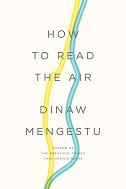by Nora Sharp
Dinaw Mengestu’s second novel, How to Read the Air, is frustratingly hard to get into, despite being the brand new book by a young writer whom many people seem to love. The novel chronicles two disintegrating relationships, as experienced by African immigrants to the United States and their children.
Mengestu’s picture of disintegrating relationships and emotional trauma—focused by slow tales of romantic death and reflected in refugee histories that turn up throughout the book—hits home pretty hard, and ultimately makes the book worth reading. But How to Read the Air never really gets off the ground. Mengestu’s explanatory style not only weighs down what should be the fiercest and freest moments of the book, but keeps us from discovering the story’s insights on our own. Early on the narrator, a young Ethiopian-American man trying to make it in New York City with an English degree, receives an extremely expensive “satchel” from his girlfriend as congratulations for a new teaching job. But we can’t just watch the narrator, Jonas, receive the gift from his eager girlfriend. We must first be told that Angela, the girlfriend,
…was one of those people who took an almost excessive pleasure in seeing their gifts received, although in her case there was nothing vain or self-serving in it, and if anything, the act of gift-giving as performed by her was fraught with danger, which made the genuine looks of surprise and pleasure that much more meaningful when they came.
It’s not bad writing, not exactly, but it just doesn’t feel fresh. Angela’s characterization is overwhelmed by this kind of analysis. Her actions rarely stand alone, and so we rarely come to understand their meaning—or the meaning of the other characters’ choices and habits—on our own. The book sometimes reads more like a memoir, or even an undergraduate paper, than a novel. There’s too much exposition, too much analysis, and not enough of the action and accidental insight that can make a novel both fun to read and moving.
The title comes from a story Jonas recalls of his father learning to “read the air” for signs of danger during his journey out of Ethiopia and to the American Midwest. As described in the story, “reading the air” is a skill of intuition, a cross between luck and self-awareness that will allow us to see clearly what’s going on in our surroundings and keep us safe, as long as we’re paying attention. Strangely enough, this idea points to one of the novel’s main faults. Jonas may articulate the meaning of his stories quite intelligently, but it’s hard to really care when we haven’t had a chance to learn things for ourselves. Mengestu never lets us read the air on our own.
This post may contain affiliate links.









